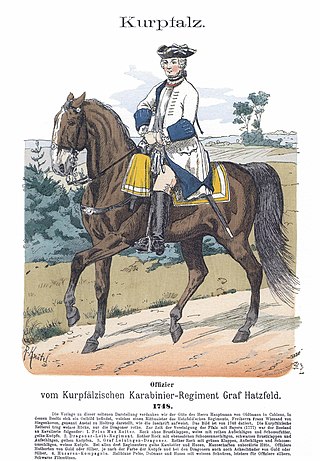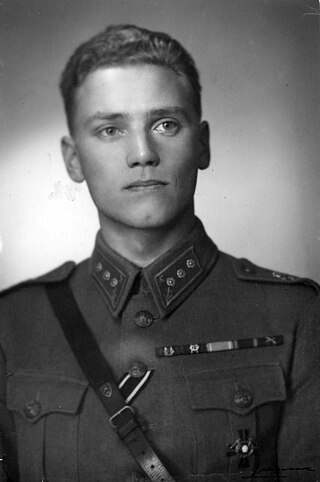Rank insignia
- Current rank insignia of a Hellenic Army Anthypolochagos
- Current rank insignia of a Cypriot National Guard Anthypolochagos
Anthypolochagos (Greek : Ανθυπολοχαγός, abbreviated Ανθλγός (Anthglos), equivalent to the NATO (OF-1), is the lowest commissioned officer rank in the Hellenic Army, except for the Armour-Cavalry Arm, and formerly, the Cavalry, in which it is called Anthypilarchos (Greek : Ανθυπίλαρχος, romanized: Anthypilarchos, abbrev. Ανθλχος (Anthlchos).
The equivalent rank is Simaiophoros (Ensign) in the Hellenic Navy, Anthyposminagos (Pilot Officer) in the Hellenic Air Force, and Ipastynomos (Inspector) in the Hellenic Police. The rank of anthypolochagos is also used in the Cypriot National Guard.
The word ανθυπολοχαγός is derived from the Greek words αντί, ύπο and λοχαγός. The preposition αντί, with the genitive or accusative case in noun phrases, or with the particle να in verb phrases, signifies "instead of". [1] : 16 The preposition ύπο means "under" [1] : 195 while the λοχαγός means " lochos leader", i.e. a captain, [1] : 109 thus υπολοχαγός means "under-captain" — which can be compared to Captain lieutenant, and ανθυπολοχαγός means "replacement under-captain", compare sub-lieutenant.
Similarly, the term for cavalry captain, Greek : ίλαρχος, romanized: ilarchos, is derived from the Modern Greek word for a cavalry troop, Greek : ίλη, romanized: ili, [1] : 180 later applied to armoured units after the conversion to Armoured cavalry. The ancestral Ancient Greek : ἴλη, romanized: ilē could mean a "band of men" or "cavalry troop", according to Arrian, properly numbering sixty-four men, especially when applied to the territorial squadrons of the Companion cavalry of the Ancient Macedonian army of Philip II. [2] The Modern Greek word for a cavalry, armoured, or aerial squadron is moira, which also applies to Special forces, airborne and artillery battalions. The officer ranks subordinate to ilarchos derive their names in a similar process those subordinate to ypolochagos.
Anthipolochagos or its equivalent is the lowest and highest rank, respectively, that can be obtained by graduates of the Hellenic Military Academy and the Corps Non-Commissioned Officers Academy, after four years of schooling for the former, and seventeen years later for the latter, at which time graduates are promoted anthipolochagos or anthipilarchos, depending on the rank borne by the arm in which they have been serving. Likewise, reserve officers are called anthipolochagi, as graduates of the Reserve Officers Academy, after a training period of four months duration, after which time they have been sufficiently educated in the tactics and leadership of their branches. During their probationary period, they are called Reserve Candidate Officers (Greek : Δόκιμος Έφεδρος Αξιωματικός, romanized: Dokimos Ephedros Anthypolochagos) and take the rank of Reserve Second Lieutenant (Greek : Έφεδρος Ανθυπολοχαγός, romanized: Ephedros Anthypolochagos) one-and-a-half months after their leaving the academy.
In Anglophone armies the rank is generally called Second lieutenant except in naval usage, where ensign or sub-lieutenant are used, and in a few cases where the archaic infantry rank of ensign is retained for historic reasons, viz. Canadian household regiments. In former times, the English-language equivalent rank to the cavalry anthipilarchos would have been cornet, which is still used as an internal form of address for a second lieutenant in the Household Cavalry and Queen's Royal Hussars. [3]
Military ranks are a system of hierarchical relationships within armed forces, police, intelligence agencies and other institutions organized along military lines. Responsibility for personnel, equipment and missions grow with each advancement. The military rank system defines dominance, authority and responsibility within a military hierarchy. It incorporates the principles of exercising power and authority into the military chain of command—the succession of commanders superior to subordinates through which command is exercised. The military chain of command is an important component for organized collective action.

A brigade is a major tactical military formation that typically comprises three to six battalions plus supporting elements. It is roughly equivalent to an enlarged or reinforced regiment. Two or more brigades may constitute a division.
Commander is a common naval officer rank as well as a job title in many armies. Commander is also used as a rank or title in other formal organizations, including several police forces. In several countries, this naval rank is termed as a frigate captain.
Ensign is a junior rank of a commissioned officer in the armed forces of some countries, normally in the infantry or navy. As the junior officer in an infantry regiment was traditionally the carrier of the regimental colours, the rank acquired the name. This rank has generally been replaced in army ranks by second lieutenant. Ensigns were generally the lowest-ranking commissioned officer, except where the rank of subaltern existed. In contrast, the Arab rank of ensign, لواء, liwa', derives from the command of units with an ensign, not the carrier of such a unit's ensign, and is today the equivalent of a major general.
Listed in the table below are the insignia—emblems of authority—of the British Army. Badges for field officers were introduced in 1810 and the insignia was moved to the epaulettes in 1880. On ceremonial or parade uniforms these ranks continue to be worn on the epaulettes, either as cloth slides or as metal clips, although on the modern 'working dress' they are usually worn as a cloth slide on the chest. Although these insignia apply across the British Army there is variation in the precise design and colours used and it can take some time to become familiar with them all.
Leading seaman is a junior non-commissioned rank or rate in navies, particularly those of the Commonwealth. When it is used by NATO nations, leading seaman has the rank code of OR-4. It is often equivalent to the army and air force rank of corporal and some navies use corporal rather than leading seaman.

Rittmaster is usually a commissioned officer military rank used in a few armies, usually equivalent to Captain. Historically it has been used Germany, Austria-Hungary, Scandinavia, and some other countries.
Modern Greek military ranks are based on Ancient Greek and Byzantine terminology.
A subaltern is a primarily British military term for a junior officer. Literally meaning "subordinate", subaltern is used to describe commissioned officers below the rank of captain and generally comprises the various grades of lieutenant.
Ypolochagos is used in the modern Greek language to mean "First Lieutenant".
Lochagos is used in the Greek language to mean "Captain". More precisely, it means "leader of a lochos". The equivalent term in the Hellenic Army Armour & Cavalry is ιλάρχος, ilarchos, 'leader of an ilē '.
Tagmatarchis, in more archaic context transliterated as Tagmatarches, anglicized as Tagmatarch, is used in the Greek language to mean "Major". More precisely, it means "commander of a tagma" (τάγμα).
The word taxiarch is used in the Greek language to mean "brigadier". The term derives from táxis 'order', in military context meaning 'an ordered formation'. In turn, the rank has given rise to the Greek term for brigade, taxiarchia. In Greek Orthodox Church usage, the term is also applied to the archangels Michael and Gabriel, as leaders of the heavenly host, and several locations in Greece are named after them.
Fähnrich is an officer candidate rank in the Austrian Bundesheer and German Bundeswehr. The word Fähnrich comes from an older German military title, Fahnenträger, and first became a distinct military rank in Germany on 1 January 1899. However, Fähnrich ranks are often incorrectly compared with the rank of ensign, which shares a similar etymology but is a full-fledged commissioned officer rank.

The army rank of captain is a commissioned officer rank historically corresponding to the command of a company of soldiers. The rank is also used by some air forces and marine forces, but usually refers to a more senior officer. Today, a captain is typically either the commander or second-in-command of a company or artillery battery. In the Chinese People's Liberation Army, a captain may also command a company, or be the second-in-command of a battalion.
Brigadier (Brig) is a senior rank in the British Army and the Royal Marines. Brigadier is the superior rank to colonel, and subordinate to major-general. It corresponds to the rank of brigadier general in many other nations.
Commandant is a military rank used in many - typically Francophone or Hispanophone - countries, where it is usually equivalent to the rank of major.
This article deals with the rank insignia of the Austro-Hungarian Army, as worn by the Austro-Hungarian Army after the reorganisation in 1867 until 1918.
Ypotagmatarchis was an army rank in the first table of organization of the Hellenic Army from the early part of the 19th century, from which it is first attested, to the mid-nineteenth century, when it was abolished. The ypotagmatarchis was the second-in-command of an under-strength battalion.
| NATO code : | OF-1 | OF-2 | OF-3 | OF-4 | OF-5 | OF-6 | OF-7 | OF-8 | OF-9 |
|---|---|---|---|---|---|---|---|---|---|
| Navy : | Simaioforos & Anthypoploiarchos | Ypoploiarchos | Plotarchis | Antiploiarchos | Ploiarchos | Archiploiarchos | Yponavarchos | Antinavarchos | Navarchos |
| Army : | Anthypolochagos & Ypolochagos Ypilarchos & Anthypilarchos (Armoured) | Lochagos Ilarchos (Armoured) | Tagmatarchis | Antisyntagmatarchis | Syntagmatarchis | Taxiarchos | Ypostratigos | Antistratigos | Stratigos |
| Air Force : | Anthyposminagos & Yposminagos | Sminagos | Episminagos | Antisminarchos | Sminarchos | Taxiarchos Aeroporias | Ypopterarchos | Antipterarchos | Pterarchos |